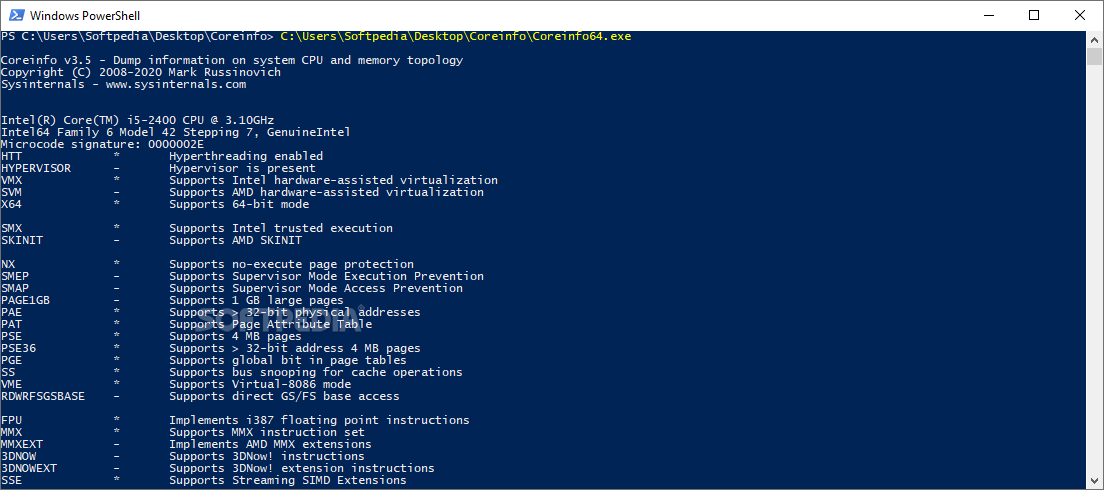
Coreinfo
3.52Useful dump information regarding your physical processors, as well as the memory configuration on your system, nodes and sockets
Coreinfo can be used for getting an insight on the system's physical processor and the memory. The application is capable of identifying the CPU model and type and retrieve detailed information regarding the mapping between logical and physical processors, cores, the NUMA node and access cost, sockets, groups and the cache sector assigned to each processor.
Coreinfo only runs using the command console and provides a wide range of options that you can choose from. Using the 'GetLogicalProcessorInformation' function of Windows, it extracts a wide range of data and displays it onto your screen.
For each resource, is enables you to view a map of the corresponding processors and the registered groups, the cache map (data, instruction, unified cache and their levels), the NUMA node map, the socket on which the processors connect to and more.
By default, the application returns a complete report of the information it reads, except the virtualization-related features, which require administrative rights to be queried. Coreinfo can tell you whether the core supports 64-bit mode, hyper-threading or hardware-assisted virtualization.
Aside from this, it offers you information on other capabilities of your system's hardware. Thus, you can use it to find out whether the processors allow page protection and execution prevention, 1GB and larger pages, page attribute table, bus snooping for performing cache operations, direct GS/FS base access and many more.
Also, it can analyze the system configuration to inform you about SIMD extension streaming, MMX instruction sets execution capabilities, the implementation of AES, AVX, RDMSR and various other types of instructions, input-output breakpoints and the list does not end here.
Coreinfo can be used for creating an overview on the hardware configuration of your system and a detailed report on the processors and the memory topology. The range of details it returns addresses advanced users who know how to evaluate each piece of information.
Coreinfo only runs using the command console and provides a wide range of options that you can choose from. Using the 'GetLogicalProcessorInformation' function of Windows, it extracts a wide range of data and displays it onto your screen.
For each resource, is enables you to view a map of the corresponding processors and the registered groups, the cache map (data, instruction, unified cache and their levels), the NUMA node map, the socket on which the processors connect to and more.
By default, the application returns a complete report of the information it reads, except the virtualization-related features, which require administrative rights to be queried. Coreinfo can tell you whether the core supports 64-bit mode, hyper-threading or hardware-assisted virtualization.
Aside from this, it offers you information on other capabilities of your system's hardware. Thus, you can use it to find out whether the processors allow page protection and execution prevention, 1GB and larger pages, page attribute table, bus snooping for performing cache operations, direct GS/FS base access and many more.
Also, it can analyze the system configuration to inform you about SIMD extension streaming, MMX instruction sets execution capabilities, the implementation of AES, AVX, RDMSR and various other types of instructions, input-output breakpoints and the list does not end here.
Coreinfo can be used for creating an overview on the hardware configuration of your system and a detailed report on the processors and the memory topology. The range of details it returns addresses advanced users who know how to evaluate each piece of information.
370 KB
Info
Update Date
Feb 22 2021
Version
3.52
License
Freeware
Created By
Sysinternals
Related software System







